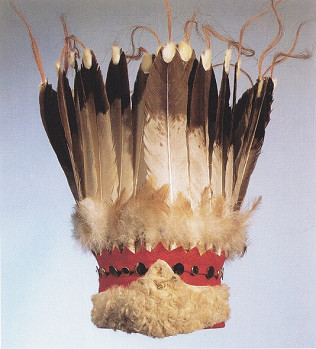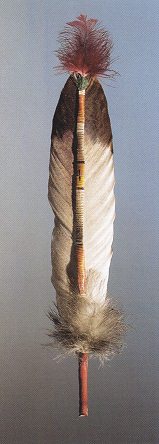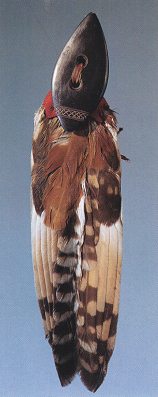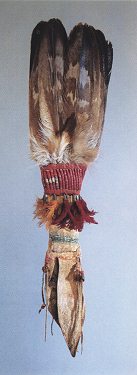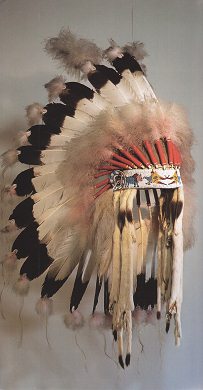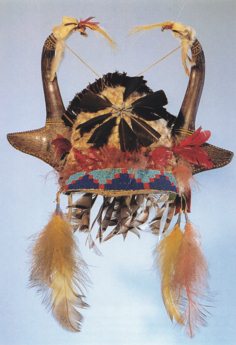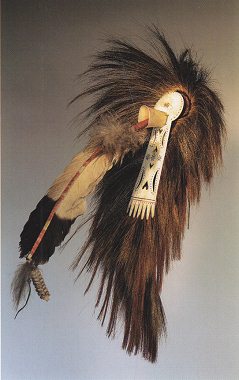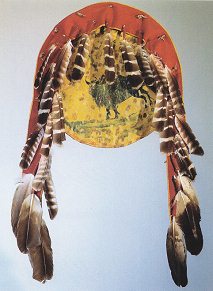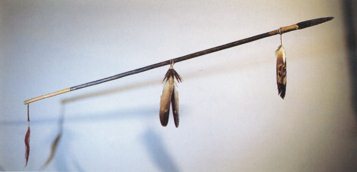|
|
|
North "American" Primary Nations Museum (North America Native Museum) Zurich
7. Native feather headdress as a reward for "brave action" or "heroic action" in the fight
Bonnet with upright feather corona of Blackfoot primary nation (photo 7)
presented and translated by Michael Palomino (2012)
Share:
|
|
|
from:
Prestel museum guide, text by Denise Daenzer and Tina Wodiunig: Native Museum of Zurich (orig. German: Indianermuseum Zürich / Indianermuseum der Stadt Zürich); Prestel edition; Munich, New York 1996; supported by Cassinelli Vogel foundation, Zurich, by MIGROS percent for culture, by Volkart foundation in Winterthur; ISBN 3-7913-1635-4
<Feather trimming and feather ornaments
[Feathers of golden eagle]
Chiefs with feather headdress are one of the most important scenes presenting brave natives - and also converted into stereotype. Feather bonnet with feathers of golden eagle designated excellent fighters and warriors, but not every native culture had this custom of feather bonnet in North America, and during the first half of 19th century it was also rare yet in the Plains and in the Prairie.
[Merits and brave actions in the fight giving the right for feather trimming - ornaments with furs or painting of certain symbols]
The right for feather trimming was only for men having succeeded in extraordinary brave actions. Successful action in war, capturing an enemy's shield, arrow and bow or a horse, or a salvation of a wounded companion from a fighting scenery, scalping of an enemy - but also the only touching of the enemy or of a tipi tent of the enemy -, all these actions were testimonies for superiority and braveness of native men. These actions had to be proved and documented in public.
One point of merit was called a "coup", a blow - and fist it meant only with touching the enemy by hand or with a stick. Later it also meant war action or brave action in general. For every successful coup was a reward, a "medal". For example a Crow native having catched a rifle was ornamenting his clothes with hemline furs. An Assiniboin fighter having robbed successfully a horse of the enemy panted his leggings with horseshoe symbols. And when he was successful in winter, the reward was a weasel fur ornamenting the sleeves of his shirt. Widely spread was also ornamenting of shirts and leggings with scalp hairs. Teton natives who could made the first blow against the defeated enemy had the right putting an eagle's feather in an upright position on the back of the head. Another person making the second blow could stick a feather in an inclined position to the left, and the third person giving the third blow could stick a feather in horizontal position.
[Symbol of honor of feather bonnet - eventually with horns - about from 1820 on - exchange of feather bonnets with beads and weapons etc.]
This bonnet has got 40 feathers, the points in black and brown. The points are ornamented with little bushels of red colored horse hair. At the sides of the beaded headband four ermine furs and long white down feathers are hanging. The headband shows the fight between an eagle and a bison.
This bonnet consists of a white leather sheath enforced by a red felt. There are 18 eagle feathers fixed in the sheath, and in front of if are down feathers sticked in. At the outer side of the red felt there are brass little discs in different forms, and there is a white fur sewed on the felt.
The horns are a headdress of a pronhorn antelope. The bonnet is made of flanel and wolf's fur. There are eight falcon feathers. The headband is worked in beading technique and is ornamented with down feathers. The back tail is missing.
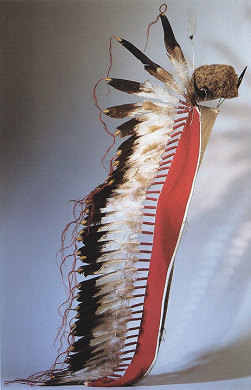
Horned bonnet with feather tail of Oglala primary nation (photo 4)
The bonnet made of fur is with two buffalo horns. Behind the bonnet there are fixed four upright feathers and the "life feather". Back tail consists of red flanel and is 1.6 m long and has got 41 eagle feathers. The points of the feathers are extended with horse hairs.
The most important of all symbols of honor was the feather bonnet. Most characteristic was the bonnet with horns and tail. A famous picture is the one of Karl Bodmer presenting Mandan chief Mato-Tope. Especially spread as head ornament were the horns of bison, antelopes, stags and of mountain sheep - above all in the Plains and in the Prairie -, and sometimes the points of the horns were drilled with holes ornamenting them with bushels of hairs, later also with colored threads (yarn) or with colored fabric straps. The presented horned bonnet (p.17) with feather tail (photo 4) was worn by Oglala natives. This bonnet made of bison fur was damaged and later complemented, but the two horns are parts of the original object. The impressive tail with 41 eagle feathers is 160 cm long. Four feathers are at the back side of the bonnet in an upright or inclined position behind the down feather, the "feather of life". This feather was the symbol for life - perhaps because down feathers are already moving in any little wind - and this down feather concentrated the forces which should protect the warrior in the fight.
When and where these bonnets with their baggy style were worn the first time cannot be said exactly any more - but they were rated as first class the native feather ornament. One admits that they were worn first between 1820 and 1830 and presumes a main spreading area in the landscapes of Upper Missouri river. At Crow ant Teton natives this form of feather bonnet was popular above all around 1830. Then came the commerce and eagle feather bonnets ware exchanged with beads, weapons and with other precious objects. As an object for commercial exchange this head ornament spread very fast - up to the North Eastern forest populations.
[Feather bonnets: eagle feathers for provable brave actions - shaping with down feathers, horse hairs, men's hairs of the enemy, furs and beading work]
Production of eagle bonnets brought some work with it. Because before the preparation of the feathers in ceremonies and fixing them, the future owner had to prove his actions in a festivity to which also friendly warriors were invited. Only this festivity showing all proofs gave the right having a feather on his head. The big numbers of feathers can also be explained by the fact that it was possible that normal warriors could transmit a coup to their war leader. And therefore any of the 40 eagle feathers of the chief's bonnet (photo 1) is representing a brave action, and every feather has got it's special place, so. Down feathers at the end of the black white feathers are colored in red, also the horse hair is colored in red. This horse hair is the symbol of a men's scalp curl of hair. Hemline furs at the sides are symbol for adored characters of this animal: his vigilance and his capacity to flee from his persecutors. The design of the beading work on the headband are probably a version or a dream of the owner and should him give courage and power in emergency situation.
Our object is showing a fight between an eagle and a bison - and this is a very strong scenery: The eagle is symbol of the predominant animal in the air being symbol for capacities of the Big Spirit and for the connection with the divine element. Bison is the most powerful animal on Earth and is the symbol for generosity, for diligence and for fertility, but is also patron saint of successful hunters.
[Feather bonnets]
Bonnets with upright feathers were above all worn by Blackfoot natives. These upright feathers were especially well loved rewards. It is assumed that only some few natives have got the privilege for wearing feather headdress, because there are only some few objects preserved.
[Feathers of young golden eagle - eagle traps]
The most beautiful and most precious feathers were the one's of golden eagle. His tail's feathers have got a black point. But only the young eagle which is not adult yet has got the well loved white color in it's feathers (p.18), and when the eagle was adult reaching his full size the feathers turned into a spotted brown. Getting the precious feathers the golden eagle was lured into a pit trap covered with leaves but with meat allurement - and this kind of hunting is tolerated until today by American animal protection laws as a "cultural" exception (p.19).
More objects with feathers of primary nations of North "America"
On the tight pad of stag hair there is fixed an ornamented pad of bone with a bony bush in which is sticked the eagle feather with a feather quill enforced by quillwork. At the top of the feather there is a down feather and a rattle of a rattlesnake.
Working with fire arms there was no protection by shields any more, but stayed the spiritual function of the shield.
This headdressing was fixed on the back side of the head and there were seven upright feathers at the back side of the owner. The middle part consist of seven raw leather straps wrapped in quillwork, and at the end is fixed a horse's tail. Such hairdressing was used for the dance fixed on the scalp's queue of a man.
Iron point of the lance comes from a sword. The shaft is ornamented with eagle feathers which was a normal kind of ornament. The rosettes with feathers come from the wild Prairie chicken and are typical for southern Prairie tribes.




